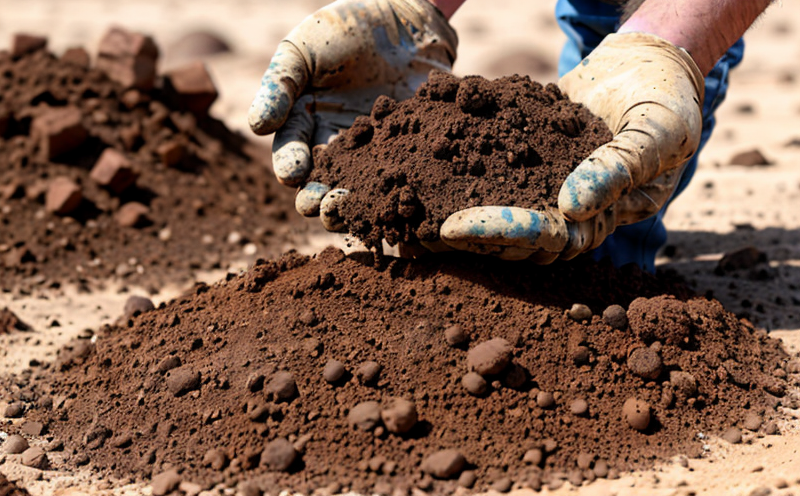ISO 17892 Part 3 Particle Size Distribution by Sieving
The ISO 17892-3 standard provides a comprehensive framework for determining the particle size distribution of soil and overburden materials through sieving. This method is widely used in mining, environmental, and civil engineering sectors to ensure that excavated materials meet specification requirements for various applications.
Particle size analysis by sieving involves separating particles into different size fractions using a set of standardized sieves with progressively finer mesh sizes. The test is performed according to ISO 17892-3, which specifies the procedures and apparatus needed to achieve accurate results. This standard ensures that all testing laboratories follow consistent methodologies, thereby enhancing reliability and comparability across industries.
The process begins by preparing a sample of soil or overburden material for sieving. The sample must be homogenized thoroughly before being divided into appropriate increments for each sieve size. Once prepared, the sample is placed on the top sieve of the set and shaken through the series of sieves until no further movement occurs.
After sieving, the retained materials in each sieve are weighed or measured. The percentage by mass of particles that pass through a particular sieve can then be calculated using these measurements. Reporting typically includes tabulated results along with graphical representations like histograms to visually depict the distribution of particle sizes within the sample.
Accurate particle size distribution data is crucial for several reasons, including optimizing blasting techniques in mining operations, ensuring proper blending and mixing processes, and meeting regulatory requirements related to environmental impact assessments. Understanding how different particles behave under various conditions helps engineers design more efficient systems that minimize costs while maximizing productivity.
In conclusion, ISO 17892-3 particle size distribution testing by sieving offers a robust approach for characterizing soil and overburden materials in the mining industry. Its application extends beyond mere compliance; it also supports informed decision-making regarding process optimization and quality control measures. By adhering to this international standard, organizations can ensure their analyses are consistent with global best practices.
Scope and Methodology
The scope of ISO 17892-3 particle size distribution testing by sieving encompasses the determination of the relative amounts of particles present in a soil or overburden sample across different size ranges. This method is particularly relevant for applications where precise knowledge of particle characteristics is essential, such as mine planning, construction projects involving earthworks, and environmental impact studies.
Methodology wise, ISO 17892-3 outlines specific steps to prepare the sample, select appropriate sieves based on expected particle sizes, conduct the sieving process effectively, record all relevant data accurately, and interpret results correctly. It emphasizes the importance of using high-quality sieves with consistent mesh openings to minimize errors during analysis.
The procedure involves several key stages:
- Sample preparation: Ensuring homogeneity through thorough mixing.
- Selecting appropriate sieves: Based on expected particle sizes as per the test requirements.
- Shaking the sample through sieves: To separate particles into distinct size fractions.
- Weighing retained materials: For each sieve after completion of shaking.
- Calculating percentages: Of particles passing or remaining on various sieves.
Accurate record keeping throughout these stages is vital to ensure reproducibility and traceability. Additionally, the use of standardized equipment and adherence to strict protocols help maintain high standards in particle size distribution analysis according to ISO 17892-3.
Why Choose This Test
- Precision: Ensures accurate measurements of particle sizes, which are critical for quality control and process optimization.
- Consistency: Adherence to international standards like ISO ensures consistent results across different laboratories worldwide.
- Compliance: Meets regulatory requirements set by environmental agencies regarding soil and overburden management.
- Efficiency: Provides valuable insights into particle behavior, aiding in the development of more effective handling methods.
Customer Impact and Satisfaction
The ISO 17892-3 test significantly impacts customers by providing them with reliable data that supports informed decision-making processes. For quality managers, it offers a tool to ensure product consistency meets internal standards; for compliance officers, it helps meet external regulatory requirements efficiently; while R&D engineers gain valuable information about particle behavior under varied conditions.
Customer satisfaction is enhanced as accurate testing leads to better outcomes in terms of cost-effectiveness and environmental responsibility. By leveraging ISO 17892-3, organizations not only comply with industry norms but also demonstrate commitment to excellence in their operations. This contributes positively towards building trust among stakeholders including clients, regulators, and the public.
Moreover, adherence to this international standard fosters a culture of continuous improvement within companies involved in mining activities. It encourages regular audits and updates to testing procedures ensuring they remain relevant and effective against current challenges faced by these industries.





